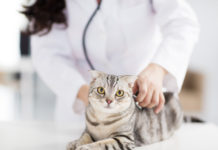Question: My 12-year-old calico cat developed mammary cancer last October. My veterinarian surgically removed several growths and felt he got all the cancer. He told me that this kind of cancer is one of the worst that a cat can get, and that it will probably return within the year. Is there anything else I can do? What can I do to protect my other cats?
Answer: Mammary cancer is truly one of the worst kinds of cancer a cat can get. Its the third most common cancer in cats (lymphoma and other types of blood cell cancers are the most common, with cancers of the skin coming in second), and accounts for nearly 20% of all cancers in female cats. Some of the characteristics that make feline mammary tumors so devastating: Up to 95% of them are malignant carcinomas that grow rapidly, are likely to recur (come back after removal), and have a great tendency to metastasize (show up in tissues distant from the original growth, such as the lymph nodes, lungs, and liver).
Your cat is in the right age range. Mammary carcinomas are usually seen in older cats (average of about 10 to 12 years of age), but very rarely, cats as young as nine months have been diagnosed. Tricolored cats, like your calico, seem to be at increased risk. And as a breed, Siamese cats are two to four times more likely to develop mammary carcinoma than are other types of female cats.
Surgery is Best Therapy
Surgical removal of all the cancerous tissue is the single most important form of therapy. Most veterinary oncologists and surgeons recommend complete removal of the entire mammary chain – either right or left – in which the lump was found. Sometimes both chains (four glands per chain in most cats) must be removed if cancer was found in both sides. Removal of the lymph nodes in the armpit or groin is sometimes suggested, too.
If possible, it is most important that sufficient tissue be removed from around all sides of the tumor so that the surgical edges are free of tumor cells. The only way to know with certainty that the surgical margins are clean is to have a veterinary pathologist microscopically examine all the margins of the excised tissue.
In addition to surgery, veterinarians may recommend chemotherapy and/or radiation therapy in certain cases. Chemotherapy may be considered if the surgical margins contain tumor cells or if cancer has metastasized to other organs. Radiation therapy is sometimes suggested in an attempt to control regrowth of the tumor at the original site; but neither chemotherapy nor radiation therapy has been consistently helpful in increasing the life span of affected cats.
Im often asked if the antiestrogen drug, tamoxifen (sometimes used in the management of breast cancer in women), would be helpful for cats. Tamoxifen binds to estrogen receptors on human breast cancer cells – present in about 60% of cases – and blocks estrogen from stimulating cancer growth. But feline mammary cancer cells rarely have estrogen receptors, so tamoxifen isnt beneficial.
Size of Tumor is Most Important
Early diagnosis of mammary cancer is extremely important because the most significant determinant of treatment outcome is the size of the tumor at the time of surgery. Approximately half of all cats with mammary tumors smaller than 2 cm in diameter (one inch is about 2.5 cm) are expected to be alive three years after surgery. Survival time falls to about two years for cats with tumors between 2-3 cm, and it is not expected to extend beyond about six months for cats with tumors larger than 3 cm in diameter.
But heres the rub: Mammary carcinoma is often well advanced by the time a veterinarian is consulted. In one study, the average time from when an owner became aware of a lump until a veterinarian was informed was 5 months – far too long. For this reason, it is extremely important that you feel the underside of the cats chest and abdomen – the area of the mammary glands – on a weekly to monthly basis. If you find any lumps, schedule an examination promptly. And make sure your veterinarian examines your cat at least once a year. Twice a year is better for cats over seven years old.
Finally – and perhaps most importantly – research proves that unspayed cats are much more likely to develop malignant mammary cancer than are spayed cats. Spaying before the first heat (which may happen as early as 4-5 months of age) probably confers the greatest protection of all.



